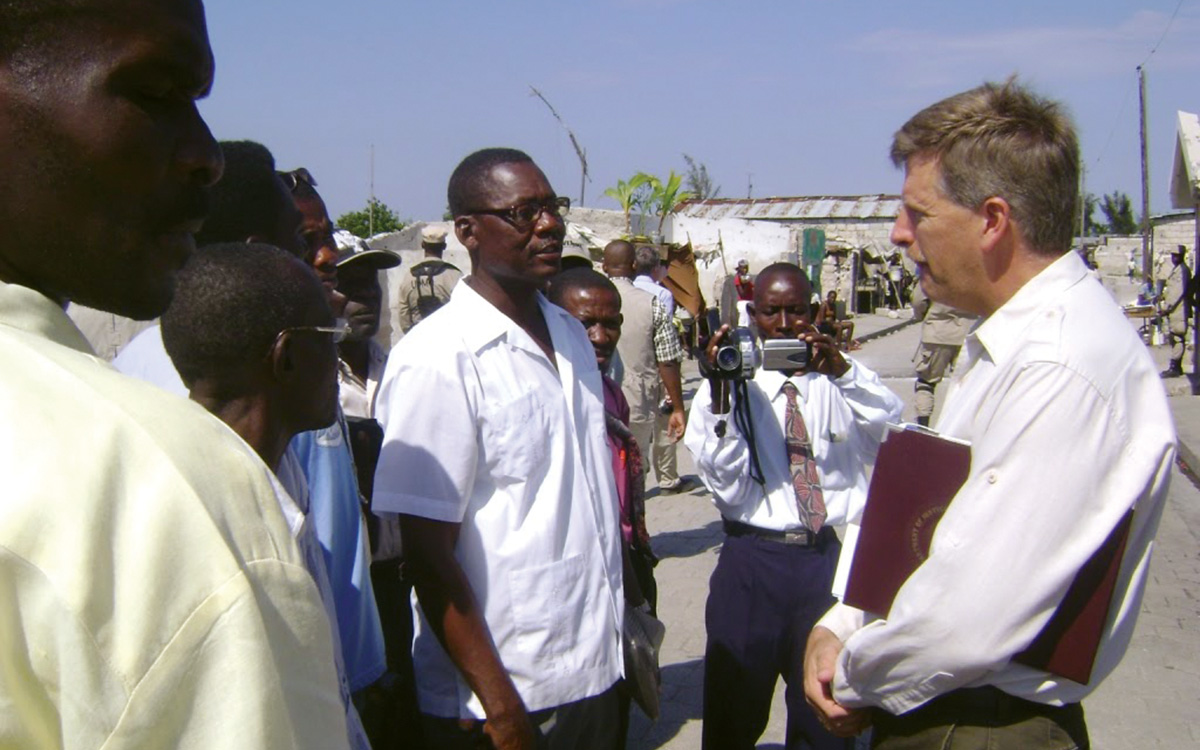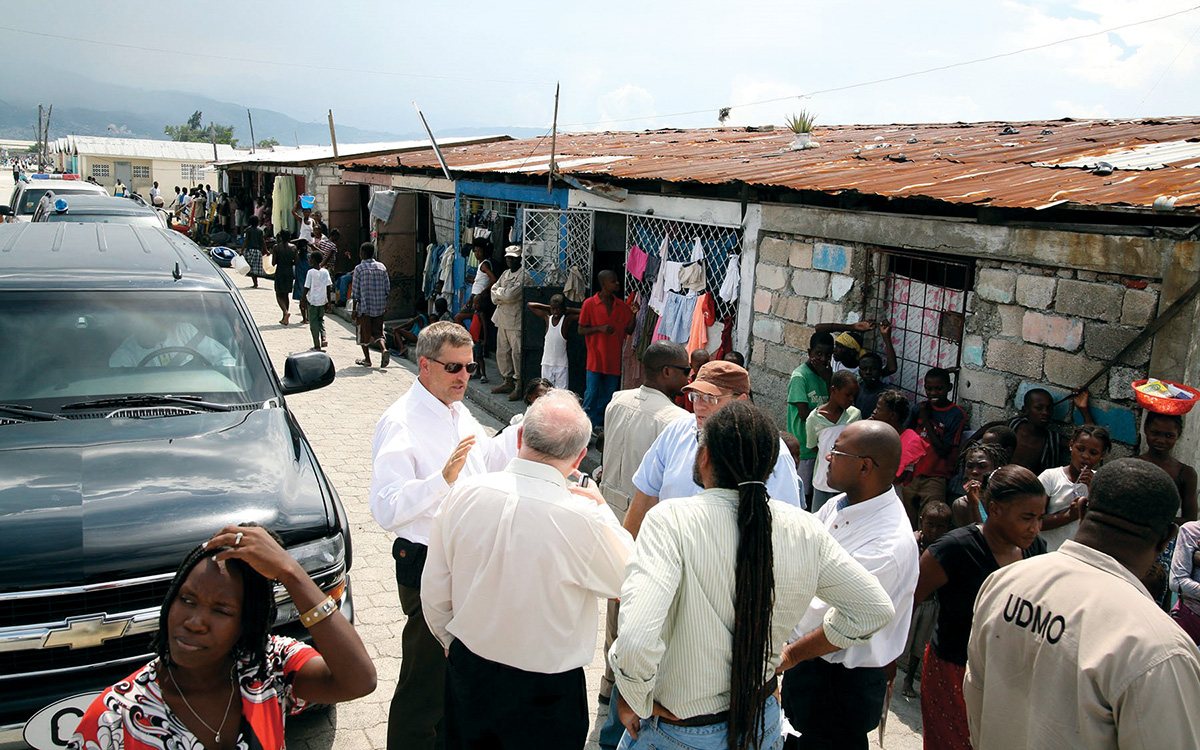Getting Preventive Stabilization on the Map
Two practitioners discuss the challenges of conflict prevention in the modern age.
BY DAVID C. BECKER AND STEVE LEWIS

David Becker, at right, hears from local leaders in Cité Soleil, Port au Prince, in 2009.
Courtesy of David Becker
Often when talking to survivors of violence in burned-out villages or bullet-pocked cement-block urban neighborhoods, we couldn’t help thinking: “This would be easier if we had been here earlier.”
Both of us have been involved in stabilization operations for years but have often wished for a time machine so we could go back and help mitigate the problems before they became crises.
The cost of violent conflict and instability is incredibly high, both in terms of human life and resources wasted. The United Nations estimates that the average cost of a civil war is $65 billion. The benefits of prevention are also significant. A United Nations report estimates that every $1 spent on prevention saves $10 in recovery costs. Prevention of violent conflict is not just common sense and fiscally sound; it is also U.S. policy, as outlined in the current National Security Strategy. Why then, if prevention saves money and lives, and is official U.S. government policy, do we have such a poor record of preventing violent conflict and stability?
This question was the focus of the Peacekeeping and Stability Operations Training and Education Workshop that drew a group of stabilization veterans, including the authors, to Carlisle, Pennsylvania, last April. Sponsored by the U.S. Army’s Peacekeeping and Stability Operations Institute (PKSOI), the workshop is an annual three-day event. This year, the group of about 50 practitioners formed six workgroups to discuss various components of stability. Our group of 10 focused on how to get ahead of the cruel curve of conflict and spiraling violence before it eventually draws the attention of the world and pulls outside nations into yet another manmade disaster. (More information about this workshop can be found at the PKSOI website: https://pksoi.armywarcollege.edu/conferences/psotew/.)
We shared personal experiences of successful and unsuccessful efforts, and we discussed the challenges prevention efforts face, as well as what's involved in planning and implementing such operations. The following is a selection of some of the most salient observations and conclusions that surfaced during our deliberations.
Toward Preventive Stabilization
Establishing conflict prevention as a rigorous discipline on the continuum of response to conflict—from ordinary political disagreements to violent hostility and war—is a work in progress.
As Robert Jenkins, U.S. Agency for International Development’s deputy assistant administrator for the Bureau for Democracy, Conflict and Humanitarian Assistance, noted in a plenary session, the U.S. military classifies stabilization operations as part of “irregular warfare”—as opposed to state-vs.-state conventional warfare. Yet even though irregular warfare (stabilization and counterterrorism and counterinsurgency) has today become the norm, compared to the vast literature on prevention of conventional conflict, “preventive stabilization” is barely recognized as a concept and has received relatively little attention from analysts, strategists and policymakers.
Importantly, in the Carlisle discussions we drew only minimally from experience based on the United States’ and NATO’s anomalously huge long-term interventions in Iraq and Afghanistan, though they nonetheless offer lessons on how and how not to carry out interventions (arguably more on the latter). Various members of the workshop had spent decades in Central America, as well as Peru, Haiti, Indonesia, Sudan and Yemen, among other locations, and this gave the group’s discussion a somewhat different perspective than the work of analysts whose primary experience is in Afghanistan and Iraq.
Building on the practical experiences of the different attendees at the workshop, we sought to define preventive stabilization more precisely, discuss some of the challenges it presents, review lessons learned and identify criteria for its successful implementation.
Defining prevention. Preventive stabilization is different from “pure” development programming, namely, long-term funding designed to improve health, education, governance and prosperity—i.e., “a rising tide lifts all boats” approach for improving the lives of many. It is not humanitarian assistance— directed at populations affected by a disaster, natural or manmade—either. For purposes of this analysis, we define post-conflict stabilization assistance as “aid to support reestablishment of safe and secure environments and to construct or reconstruct critical infrastructure and restart economic activity.”
In light of this, what does “preventive stabilization” entail? The group did not reach a clear consensus, although we concurred that examples from USAID’s Office of Transition Initiatives, Canada’s START program (now the Peace and Stability Operations program) and the United Kingdom’s Department for International Development projects sometimes seem to apply.
Some participants cited programs conducted by USAID and the State Department’s Bureau of International Narcotics and Law Enforcement—for example, working with police and social groups in Central American slums run by gangs. But those cases seemed to be actual stabilization missions rather than preventive missions, as the gangs are already clearly armed opponents of the government and local leadership.
Development dollars do not equal prevention. The primary challenge of preventive stabilization, most practitioners agree, is not insufficient funding for development. Although devoting more resources to development assistance might well be worthwhile in its own right, increasing local access to education and boosting incomes will not magically resolve societal conflicts. In fact, unequal development (when, for instance, investment pours in from outside the conflict zone for resource exploitation— oil, diamonds, timber, etc.) can actually exacerbate existing frictions into open war. More dollars alone won’t solve the conflict patterns.
Good prevention is hard to find. It is difficult to come up with clear examples of preventive stabilization. As practitioners, we are almost always funded and arrive only after conflict has consumed a country, not before. Ironically, we practitioners might not have heard of successful preventive efforts—precisely because they were successful. And, participants noted, even if you are there as a prevention measure, it is very difficult to prove that you averted an adverse outcome.
We did discuss some instances of modest intervention that may have stopped a return to violence during a pause or lull in the cycle of ongoing violence. In Haiti, according to a participant who worked there with the Haiti Stabilization Initiative in 2008, a group of street leaders working with the initiative said they were tired of being used as rent-a-mobs by political actors. They therefore voted to run the bagman of a businessman’s political party out of the Cité Soleil slum as a message that they were no longer in the violence-on-demand business. When the capital was convulsed by food riots that threatened to topple the government later that year, only one poor neighborhood did not participate in the violence: Cité Soleil.
Another practitioner reported a similar experience in Indonesia. When interreligious violence in Central Sulawesi province finally subsided after four years of intermittent fighting, the Jemaah Islamiyah terrorist group launched attacks to rekindle tensions. The USAID staff, along with some of their implementing partners, facilitated dialogue between Christian and Muslim community leaders, helping both groups realize that it was an outside group that was trying to shatter the precarious peace. This headed off a return to large-scale violence.
“Preventive stabilization” is barely recognized as a concept, and it has received relatively little attention from analysts, strategists and policymakers.
How do you know when to intervene? Identifying incipient conflict or low-level conflicts before they become the sort of stabilization crisis that we have so often failed to resolve is a major challenge.
How does one distinguish the conflict that is healthy political friction, or at least controllable disagreement, from the conflict that will become an all-consuming cancer? Is Sudan about to break down, or is it simply going through another difficult transition? How about Venezuela? Or Thailand?
There are ongoing efforts to identify “fragile states” using readily available indicators, but there is still no agreement on which indicators are significant predictors. And, of course, local conflicts are by definition “local.” In other words, they don’t draw attention to themselves early on.
Competition for attention and funds. When working in Haiti following the United Nations intervention, David Becker often heard from the slum dwellers: “You are only here spending money because we finally started fighting back.” Or, “Until the gangs started to kidnap rich businessmen’s kids, no one cared about us.” They were not entirely wrong.
Preventing instability is simply not interesting for most donor countries. Western democracies tend to be self-absorbed—their priorities center around their own relatively immediate interests, and those interests (and funding) seldom call for intervening in a foreign land. Unless the conflict has grown to the point that it threatens the stability of a neighboring state, weakens an allied government or is risking the lives of millions, it is probably not going to be a priority.
This problem is complicated by the fact that funding prevention programs would probably mean diverting money from existing crisis response funds, creating bureaucratic wars even before the conflict has broken out on the ground.
Pull together with partners. Despite problems of recognition and funding, the fact that prevention is part of a continuum of responses to conflict means that, just like traditional stabilization operations, the process of creating a strategy for crisis prevention, identifying resources and engaging partners requires maximum buy-in from agencies and assets traditionally designed to respond to crises. On the ground, successful prevention of instability comes from a mix of understanding the local environment, building a team and gaining broad institutional support from local partners to address the driving factors of instability.
This parallels the process for successful stabilization efforts in general. Indeed, most lessons from post-conflict stabilization operations apply equally well to pre-conflict stabilization efforts.
To understand and adapt to a changing local environment, it is critical to develop and engage a network of local and international partners from a variety of sectors: government, international organizations, embassies, military, police, national disaster management authorities, nongovernmental organizations and civil society. They can all help address the driving factors of instability, as well as identify the early-warning signs that may lead to a crisis.
In contrast to the Iraq and Afghanistan models, however, the U.S. government is probably not going to be the dominant player on the field in a preventive stabilization operation. But even as a much smaller player, the design of a U.S. team is extremely important. It is critical to include the right members in decision-making and implementation processes, while recognizing respective differences in their mandates. In other words, there may be a “core” team group and “support” partner group(s), depending on the role and capability of each member. These could be U.S. government agencies, but more likely will be drawn from international organizations and local society.

David Becker, in dark glasses, talks with colleagues during a visit to Cité Soleil in 2009.
Courtesy of David Becker
Practitioners noted, however, that while a U.N.-structured response could be very helpful in bringing in new outside partners such as China, Russia or other countries, in some cases a response can be hamstrung by being too inclusive. So, we concluded, the United Nations must find the best balance.
Go for local solutions, locally led. The U.S. government may in some cases provide enthusiastic backing and support on the ground, which is great, of course. But more often, Washington will be reluctant to face facts about the severity of a problem. The same reluctance is probably even more true of the local government. In some cases, this denial factor may be greater in pre-conflict than post-conflict situations. A festering conflict is often ignored until violence results.
The challenge that practitioners identified is to make sure that the planning and implementation of a preventive stabilization operation are locally led. Participants recounted horror stories of prevention efforts being undermined by lack of host-government buy-in. Yet there is often real dedication to solutions at the most local level.
One way to resolve some of these government-to-government conflicts might well be to work at the grassroots level first, with those directly affected in the situation. Rather than forcing things to improve from the top down, working from the bottom up may be more effective. It also avoids some of the immediate pitfalls and resource conflicts. Of course, a proper balance is needed. As success becomes evident, higher-level buy-in may be more likely.
Put metrics first. Assessment criteria need to be established early and tested. The challenge of “proving prevention” is overwhelming, but it is made much worse if efforts are not tracked and measured from the beginning, and against a commonly agreed yardstick. Too often, assessment is an afterthought, when it needs to be part of the planning from the start.
Enhancing the Chances of Success
The Carlisle participants concurred that it is possible for international actors to prevent instability from growing past the point of no return. But it is extremely difficult to predict where instability will manifest, and determine how to invest meager resources to stop the process.
However, our group of practitioners found a glimmer of hope in acknowledging some basic requirements: a thorough understanding of the local environment and culture, a strong network of like-minded partners from both the international community and the local community, and a willingness to take modest risks with meager resources.
This formula will not prevent every crisis, but it may allow us to forestall a few. And for that reason, it is certainly worth the relatively modest investment.








